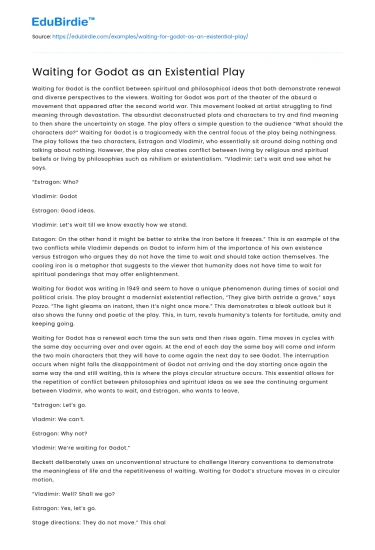Waiting for Godot is the conflict between spiritual and philosophical ideas that both demonstrate renewal and diverse perspectives to the viewers. Waiting for Godot was part of the theater of the absurd a movement that appeared after the second world war. This movement looked at artist struggling to find meaning through devastation. The absurdist deconstructed plots and characters to try and find meaning to then share the uncertainty on stage. The play offers a simple question to the audience “What should the characters do?” Waiting for Godot is a tragicomedy with the central focus of the play being nothingness. The play follows the two characters, Estragon and Vladimir, who essentially sit around doing nothing and talking about nothing. However, the play also creates conflict between living by religious and spiritual beliefs or living by philosophies such as nihilism or existentialism. “Vladimir: Let’s wait and see what he says.
“Estragon: Who?
Save your time!
We can take care of your essay
- Proper editing and formatting
- Free revision, title page, and bibliography
- Flexible prices and money-back guarantee
Vladimir: Godot
Estragon: Good ideas.
Vladimir: Let’s wait till we know exactly how we stand.
Estagon: On the other hand it might be better to strike the iron before it freezes.” This is an example of the two conflicts while Vladimir depends on Godot to inform him of the importance of his own existence versus Estragon who argues they do not have the time to wait and should take action themselves. The cooling iron is a metaphor that suggests to the viewer that humanity does not have time to wait for spiritual ponderings that may offer enlightenment.
Waiting for Godot was writing in 1949 and seem to have a unique phenomenon during times of social and political crisis. The play brought a modernist existential reflection, “They give birth astride a grave,” says Pozzo. “The light gleams an instant, then it’s night once more.” This demonstrates a bleak outlook but it also shows the funny and poetic of the play. This, in turn, revals humanity’s talents for fortitude, amity and keeping going.
Waiting for Godot has a renewal each time the sun sets and then rises again. Time moves in cycles with the same day occurring over and over again. At the end of each day the same boy will come and inform the two main characters that they will have to come again the next day to see Godot. The interruption occurs when night falls the disappointment of Godot not arriving and the day starting once again the same way the and still waiting, this is where the plays circular structure occurs. This essential allows for the repetition of conflict between philosophies and spiritual ideas as we see the continuing argument between Vladmir, who wants to wait, and Estragon, who wants to leave,
“Estragon: Let’s go.
Vladmir: We can’t.
Estragon: Why not?
Vladmir: We’re waiting for Godot.”
Beckett deliberately uses an unconventional structure to challenge literary conventions to demonstrate the meaningless of life and the repetitiveness of waiting. Waiting for Godot’s structure moves in a circular motion,
“Vladimir: Well? Shall we go?
Estragon: Yes, let’s go.
Stage directions: They do not move.” This challenges literary conventions as there is no character development or plot movement but rather moving around in circles which in turn demonstrates the nihilistic theme throughout the play. Beckett demonstrates a nihilistic vision with the avoidance of metaphysical archetypes and connecting structure such as redemption of hope after despare.






 Stuck on your essay?
Stuck on your essay?

